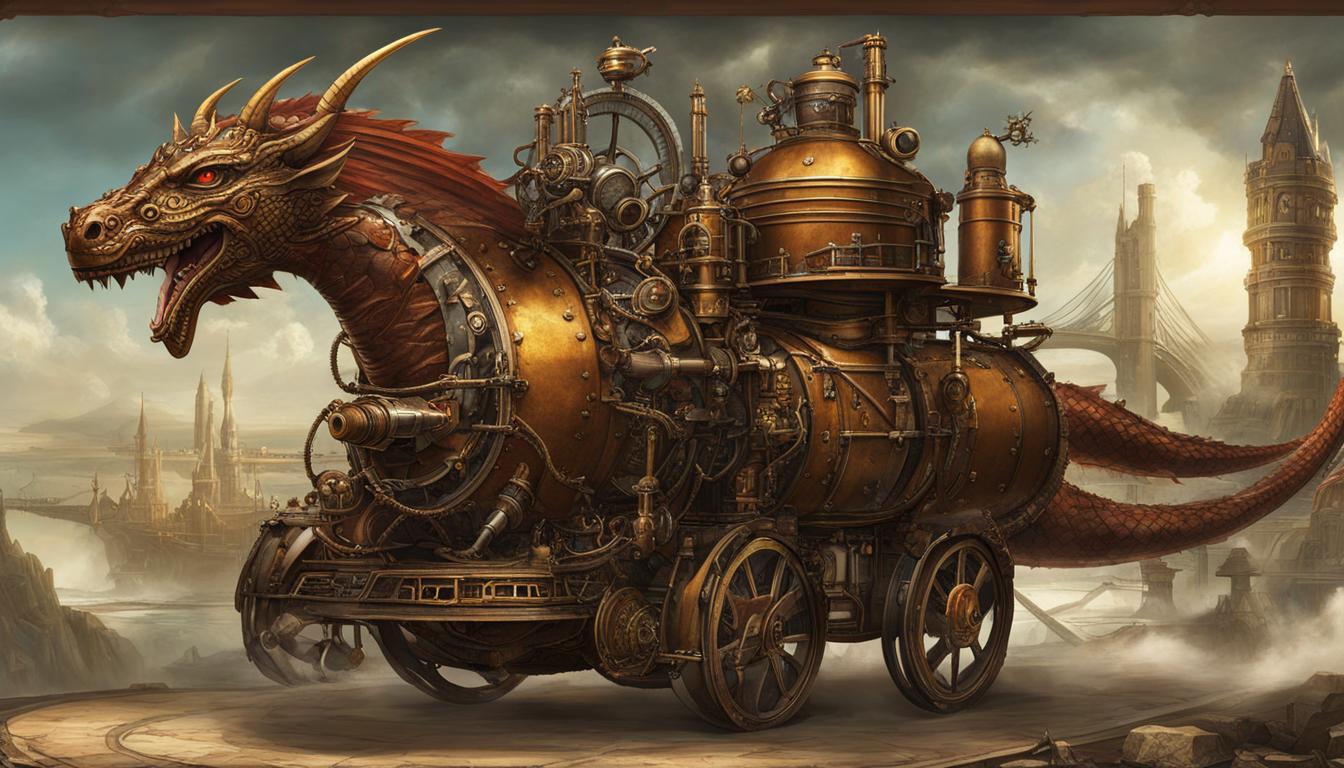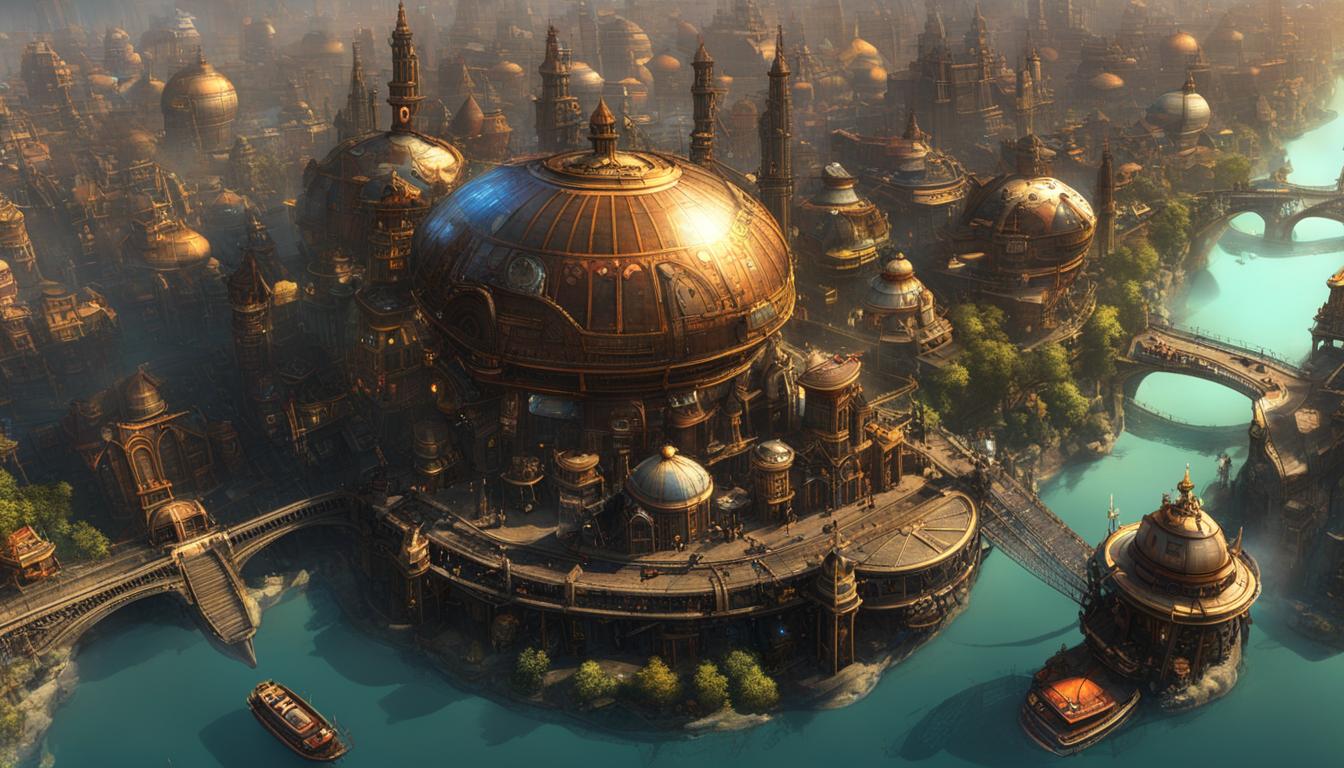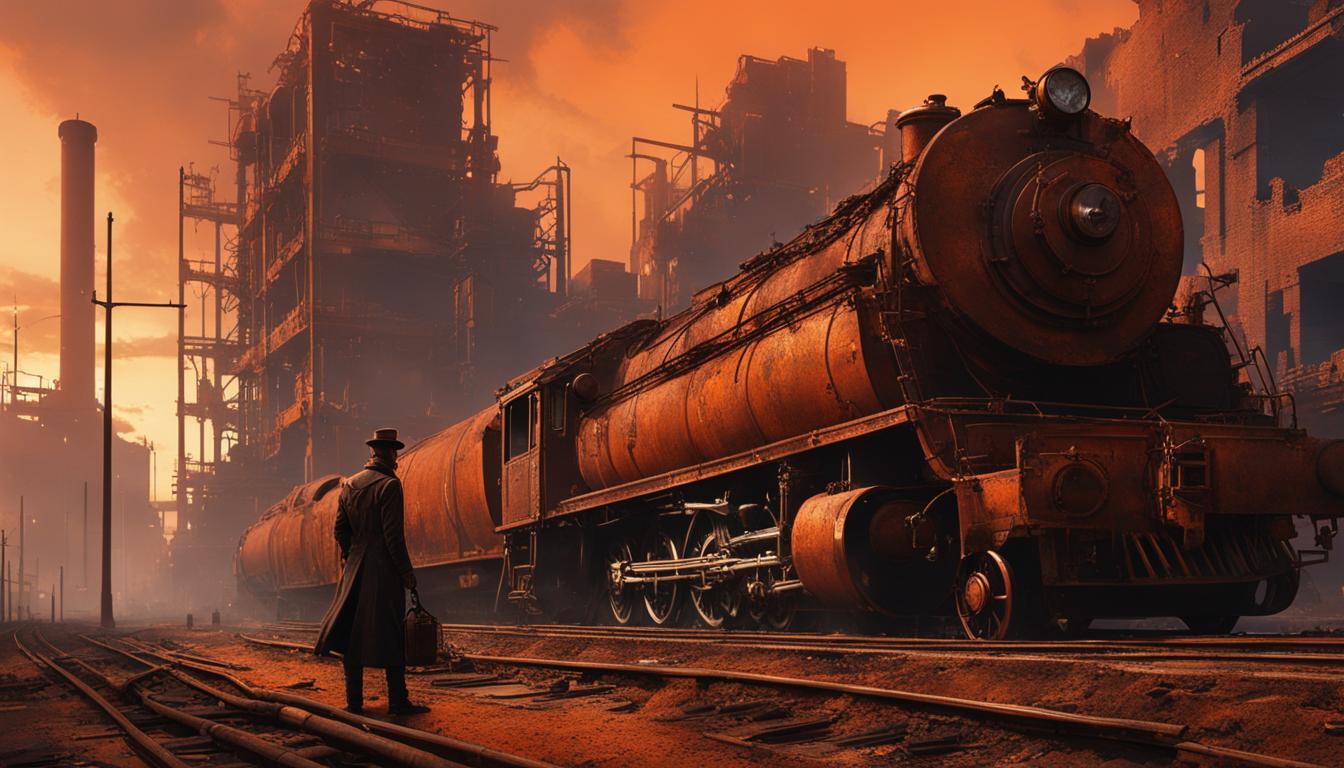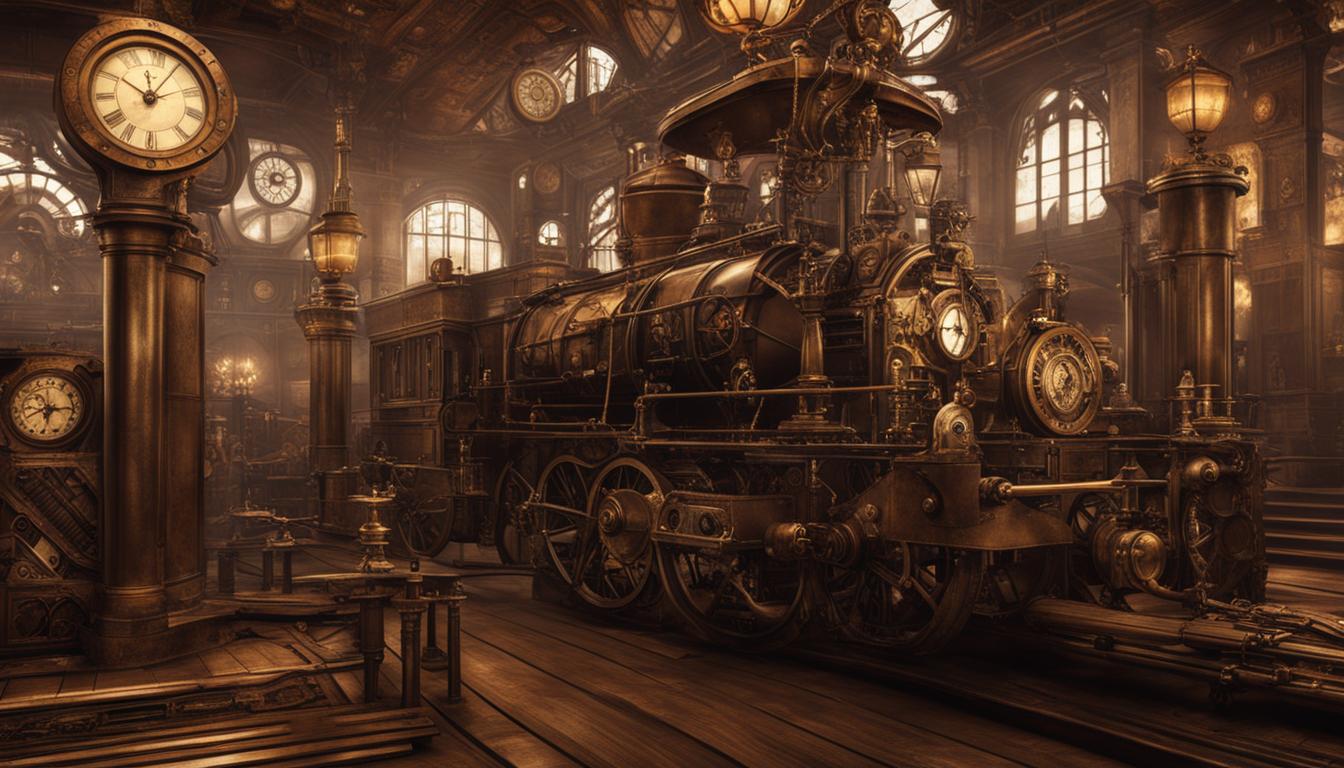Steampunk, the captivating subgenre of science fiction, brings together a fascinating blend of genres, creating a literary experience like no other. With its retrofuturistic technology and aesthetics inspired by 19th-century steam-powered machinery, steampunk transports readers to alternative histories of the Victorian era and the American Wild West, where steam power reigns supreme. But what sets steampunk apart is its ability to seamlessly intersect with other literary genres, offering a genre fusion that is both imaginative and enticing.
Steampunk originated in the 1980s but encompasses works created as far back as the 1950s, if not earlier. It not only encompasses a range of literary styles but has also given rise to artistic styles, clothing fashions, and subcultures that draw inspiration from its rich and diverse fictional world.
Key Takeaways:
- Steampunk is a subgenre of science fiction that incorporates retrofuturistic technology and aesthetics.
- It blends elements from genres like fantasy, horror, historical fiction, and alternate history.
- Steampunk’s genre fusion creates a fresh and captivating storytelling experience.
- It appeals to readers who enjoy multiple genres and appreciate the blending of literary styles.
- Steampunk’s intersections with other genres make it a highly appealing genre for fans of all types of fiction.
The Main Elements of Steampunk
Steampunk is a genre that combines the aesthetics of the Victorian era with steam-powered machinery, creating a unique blend of history and technology. The main elements of steampunk revolve around these two core concepts, creating a visually captivating and intellectually intriguing genre.
In terms of setting, steampunk stories often take place in the Victorian era or a fictionalized version of it. This means that the fashion, architecture, and societal norms of the time play a significant role in the storytelling. From corsets and top hats to cobbled streets and gas lamps, the visual elements of steampunk transport readers to a bygone era.
On the other hand, the technology in steampunk is often anachronistic, featuring steam-powered machinery and inventions that fuse the past with futuristic concepts. These imaginative contraptions form the backbone of many steampunk narratives, ranging from clockwork devices to elaborate airships. This collision of history and technology is a key aspect of the genre’s appeal.
“Steampunk is like science fiction, but with a twist of nostalgia and adventure.”
The DIY and Maker Culture
One of the unique aspects of steampunk is its DIY and maker culture. Enthusiasts of the genre are often encouraged to create their own steampunk-inspired creations and designs. This can range from crafting elaborate costumes and accessories to building functional gadgets and contraptions.
The DIY and maker culture of steampunk reflects the genre’s emphasis on individualism and creativity. It is a way for fans to express their passion for the genre and participate in a community that celebrates ingenuity and craftsmanship.
A Hybrid Genre with Elements of Science Fiction
Steampunk is a hybrid genre that incorporates elements of science fiction, fantasy, and horror. While it is primarily known for its Victorian-era settings and steam-powered machinery, it also explores futuristic concepts and technologies. This blend of genres allows for a diverse range of storytelling possibilities, combining the familiar with the extraordinary.
Whether it’s the exploration of alternate histories, the inclusion of supernatural elements, or the incorporation of imaginative technology, steampunk offers a rich and captivating reading experience. It appeals to fans of multiple genres and provides a platform for creativity and imagination to thrive.
| Victorian-era Settings | Steam-powered Machinery | Intersection of History and Technology | Elements of Science Fiction | DIY and Maker Culture |
|---|---|---|---|---|
| Transport readers to a visually captivating era | Create anachronistic steam-powered inventions | Explore the collision of history and technology | Incorporate futuristic concepts and technologies | Encourage fans to create their own steampunk-inspired designs |
Steampunk and Science Fiction: A Comparison
Steampunk and science fiction are two closely related genres that share similarities but also have distinct differences. While both genres explore futuristic technology and new worlds, they approach these concepts in unique ways. Steampunk, with its Victorian-era focus, offers a glimpse into a retrofuturistic world where advanced technology is powered by steam and gears.
In contrast, science fiction encompasses a broader range of settings and time periods, often delving into space exploration and advanced technologies that go beyond the constraints of the Victorian era. Steampunk’s appeal lies in its ability to reimagine history, blending elements of the past with inventive technological advancements.
The Victorian-Era Focus of Steampunk
One of the defining characteristics of steampunk is its deep connection to the Victorian era. It draws inspiration from the aesthetics, fashion, and culture of this time period, creating a sense of nostalgia and adventure. Steampunk narratives often take place in an alternative version of the 19th century, where steam-powered machinery dominates and fantastical inventions abound.
On the other hand, science fiction is not limited to any specific historical period and can explore futuristic worlds, alternate realities, and even the present day. The focus of science fiction is to imagine what could be possible in the future, while steampunk reimagines what could have been in the past.
Futuristic Technology and Exploration of New Worlds
Steampunk and science fiction both delve into the realm of futuristic technology and the exploration of new worlds. However, their approaches to these concepts differ. Steampunk often portrays technology that is advanced for its time, featuring airships, clockwork devices, and other imaginative inventions. The exploration in steampunk is often centered around uncovering new discoveries hidden within the confines of the Victorian era.
In contrast, science fiction explores a wider range of futuristic technologies, such as space travel, artificial intelligence, and genetic engineering. It takes readers on journeys to distant planets, alternate dimensions, and even parallel universes. The focus of science fiction is often on pushing the boundaries of what is scientifically possible and exploring the implications of these advancements on humanity and society.
Table: A Comparison of Steampunk and Science Fiction
| Steampunk | Science Fiction |
|---|---|
| Set in the Victorian era | Set in various time periods |
| Advanced technology within a historical context | Advanced technology pushing the boundaries of what is possible |
| Focus on the intersection of history and technology | Exploration of future possibilities and their impact on society |
| Imaginative reimagining of the past | Imagining what is possible in the future |
| Often incorporates elements of fantasy and alternate history | Explores a wide range of scientific concepts and futuristic worlds |
Steampunk’s Intersection with Other Literary Genres
Steampunk is a genre that embraces the fusion of various literary styles, creating a captivating blend of alternate history, fantasy elements, and genre blending. This unique genre allows authors to explore imaginative narratives that incorporate elements from fantasy, horror, historical fiction, and alternate history, resulting in a rich and vibrant storytelling experience.
Steampunk’s alternate history settings provide a platform for creative reimagining of the past, allowing authors to weave intriguing narratives that diverge from conventional historical events. By incorporating elements of fantasy, such as magical creatures or supernatural phenomena, steampunk adds a touch of the extraordinary to its narratives, enhancing the sense of adventure and wonder.
The genre fusion in steampunk offers readers a fresh take on familiar literary themes. By blending various genres, steampunk creates a unique narrative landscape that appeals to fans of multiple genres. Whether it’s the Victorian-era aesthetics merged with futuristic technology or the exploration of alternate histories intertwined with fantasy elements, steampunk’s genre blending presents readers with a captivating and multidimensional storytelling experience.
The Intersection of Genres in Steampunk
Steampunk effortlessly weaves together the elements of alternate history, fantasy, and genre fusion. It provides a platform for authors to explore diverse thematic landscapes, combining different literary styles to create something entirely new and exciting. The genre’s ability to seamlessly blend historical and fantastical elements results in narratives that are both nostalgic and imaginative, appealing to readers who crave the unexpected.
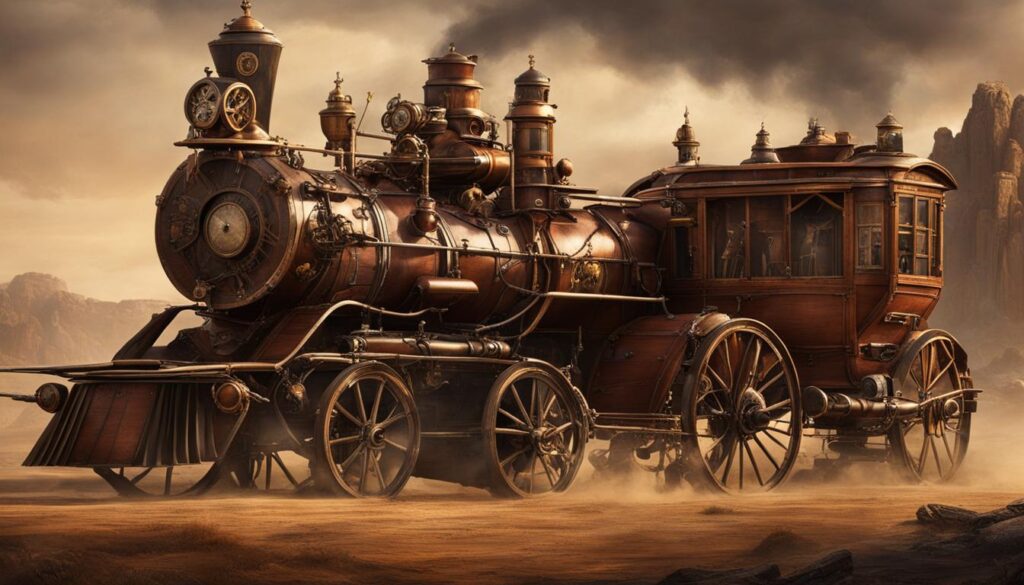
Steampunk’s intersection with other literary genres is a testament to its versatility and cross-genre appeal. By embracing elements from various genres, steampunk offers a fresh and captivating storytelling experience that pushes the boundaries of traditional literary categorizations. It is a genre that invites readers to embark on thrilling adventures in worlds that are simultaneously familiar and fantastical.
| Genre | Key Elements |
|---|---|
| Fantasy | Magic, mythical creatures, supernatural phenomena |
| Horror | Gothic atmosphere, macabre themes, suspense |
| Historical Fiction | Alternate history, Victorian-era settings, real-world events |
| Alternate History | Reimagined historical events, divergent timelines |
Steampunk is a literary playground where genres collide, resulting in narratives that are both familiar and fantastical. It offers readers a chance to explore imaginative reimaginings of history and experience thrilling adventures that defy traditional categorizations.
Conclusion
Steampunk’s cross-genre appeal has made it a beloved genre for readers of all kinds. With its unique blend of historical settings, futuristic technology, and fantasy elements, steampunk literature offers a captivating storytelling experience that transcends traditional genre boundaries.
The genre mix in steampunk allows for the blending of literary styles, creating a rich and vibrant tapestry of storytelling. From the imaginative re-imaginings of history in alternate history steampunk to the supernatural elements found in fantasy steampunk, this genre offers a fresh and exciting literary experience.
Steampunk’s ability to bridge the gap between different genres is what sets it apart in the world of literature. Whether it’s the Victorian-era aesthetics, the imaginative inventions, or the exploration of alternate histories, steampunk sparks the imagination and provides a platform for creativity to thrive.
FAQ
What is steampunk?
Steampunk is a subgenre of science fiction that incorporates retrofuturistic technology and aesthetics inspired by 19th-century industrial steam-powered machinery.
When is steampunk typically set?
Steampunk is often set in an alternative history of the Victorian era or the American Wild West, where steam power remains in mainstream use.
What are the main elements of steampunk?
The main elements of steampunk include Victorian-era settings and aesthetics, steam-powered machinery and technology, and a focus on the intersection of history and technology.
What genres does steampunk incorporate?
Steampunk incorporates elements from other genres like fantasy, horror, historical fiction, and alternate history, making it a hybrid genre.
How does steampunk differ from traditional science fiction?
While steampunk is a subgenre of science fiction, it differs in its focus on the Victorian era and retrofuturistic technology that is advanced for that time period.
What are some common themes in steampunk?
Common themes in steampunk include alternate histories, airships, clockwork devices, and elements of the supernatural.
How does steampunk appeal to readers?
Steampunk’s blend of historical settings, futuristic technology, and genre fusion creates a captivating storytelling experience that appeals to readers who enjoy multiple genres.
What is the DIY and maker culture in steampunk?
Steampunk is characterized by a DIY and maker culture, with a focus on creating one’s own steampunk-inspired creations and designs.
What is steampunk’s cross-genre appeal?
Steampunk’s cross-genre appeal allows it to attract readers who enjoy multiple genres and appreciate the blending of literary styles.
What does steampunk offer to literary fans?
Steampunk offers a fresh and exciting literary experience for fans of all genres, bridging the gap between different literary styles and providing a platform for creativity and imagination to thrive.

